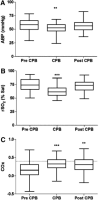Monitoring cerebral blood flow pressure autoregulation in pediatric patients during cardiac surgery
- PMID: 20651273
- PMCID: PMC5498798
- DOI: 10.1161/STROKEAHA.109.575167
Monitoring cerebral blood flow pressure autoregulation in pediatric patients during cardiac surgery
Abstract
Background and purpose: The limits of cerebral blood flow-pressure autoregulation have not been adequately defined for pediatric patients. Mean arterial blood pressure below these limits might contribute to brain injury during cardiac surgery. The purpose of this pilot study was to assess a novel method of determining the lower limits of pressure autoregulation in pediatric patients supported with cardiopulmonary bypass.
Methods: A prospective, observational pilot study was conducted in children (n=54) undergoing cardiac surgery with cardiopulmonary bypass for correction of congenital heart defects. Cerebral oximetry index (COx) was calculated as a moving, linear correlation coefficient between slow waves of arterial blood pressure and cerebral oximetry measured with near-infrared spectroscopy. An autoregulation curve was constructed for each patient with averaged COx values sorted by arterial blood pressure.
Results: Hypotension was associated with increased values of COx (P<0.0001). For 77% of patients, an individual estimate of lower limits of pressure autoregulation could be determined using a threshold COx value of 0.4. The mean lower limits of pressure autoregulation for the cohort using this method was 42+/-7 mm Hg.
Conclusions: This pilot study of COx monitoring in pediatric patients demonstrates an association between hypotension during cardiopulmonary bypass and impairment of autoregulation. The COx may be useful to identify arterial blood pressure-dependent limits of cerebral autoregulation during cardiopulmonary bypass. Larger trials with neurological outcomes are indicated.
Conflict of interest statement
ICM+ software is licensed by the University of Cambridge, Cambridge Enterprise Ltd. P.S. and M.C. have a financial interest in a part of licensing fee. Under a licensing agreement with Somanetics, K.B. is entitled to a share of fees and royalty received by The Johns Hopkins University on the monitoring technology described in this article. The terms of this arrangement are being managed by the Johns Hopkins University in accordance with its conflict of interest policies.
Figures




References
-
- Galli KK, Zimmerman RA, Jarvik GP, Wernovsky G, Kuypers MK, Clancy RR, Montenegro LM, Mahle WT, Newman MF, Saunders AM, Nicolson SC, Spray TL, Gaynor JW. Periventricular leukomalacia is common after neonatal cardiac surgery. J Thorac Cardiovasc Surg. 2004;127:692–704. - PubMed
-
- Mahle WT, Tavani F, Zimmerman RA, Nicolson SC, Galli KK, Gaynor JW, Clancy RR, Montenegro LM, Spray TL, Chiavacci RM, Wernovsky G, Kurth CD. An MRI study of neurological injury before and after congenital heart surgery. Circulation. 2002;106:I109–114. - PubMed
-
- Pua HL, Bissonnette B. Cerebral physiology in paediatric cardiopulmonary bypass. Can J Anaesth. 1998;45:960–978. - PubMed
-
- Wernovsky G, Shillingford AJ, Gaynor JW. Central nervous system outcomes in children with complex congenital heart disease. Curr Opin Cardiol. 2005;20:94–99. - PubMed
-
- Shillingford AJ, Glanzman MM, Ittenbach RF, Clancy RR, Gaynor JW, Wernovsky G. Inattention, hyperactivity, and school performance in a population of school-age children with complex congenital heart disease. Pediatrics. 2008;121:e759–e767. - PubMed
Publication types
MeSH terms
Grants and funding
LinkOut - more resources
Full Text Sources
Other Literature Sources
Medical

